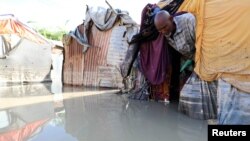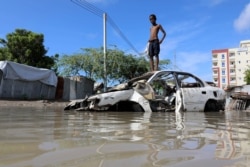Emergency assistance is starting to pour into Somalia, where hundreds of thousands have been driven from their homes by severe flooding.
More than 300,000 people have been made homeless by some of the worst flooding experienced by Somalia in years. Parts of the country, especially in the central Somali district of Belet Weyne, have been devastated.
Aid agencies are responding with increasing speed. For example, the World Food Program has distributed ready-to-eat food and high energy biscuits to thousands of the displaced.
The U.N. Migration Agency has delivered more than 3,200 non-food supply kits containing blankets, mattresses and kitchen sets.
The U.N. refugee agency this week delivered humanitarian supplies in the first of a series of flights organized to help more than 20,000 people cut off by the flooding.
UNHCR spokesman Andrej Mahecic says up to 10 flights, three a day, are scheduled to airlift 60 metric tons of supplies.
“The air operation largely depends on landing strips being available as floodwaters have engulfed a vast area," Mahecic said. "Reports of our partners indicate that villages on the outskirts of Belet Weyne, which is about 340 kilometers north of the capital Mogadishu have been submerged and hundreds of families are trapped in their homes.”
In the meantime, the World Health Organization warns many flood-hit districts have become cholera hotspots with few health care facilities available to treat the sick. It says there also has been an upsurge of malaria and diarrhea.
WHO spokesman Tarek Jasarevic tell VOA the floods give rise to other health issues.
“One of them is obviously injuries. People get injured. There is a risk of drowning," said Jasarevic. "There is a risk of people being cut, just walking through the water, stepping on nails or on glass. And, then there is also the issue of access to health services because the health facilities become difficult to reach.”
U.N. officials warn disasters such as the Somali floods highlight the increasing vulnerabilities of people in this country and others to the effects of global warming and climate change. They note this latest calamity was preceded by a severe drought in July.







